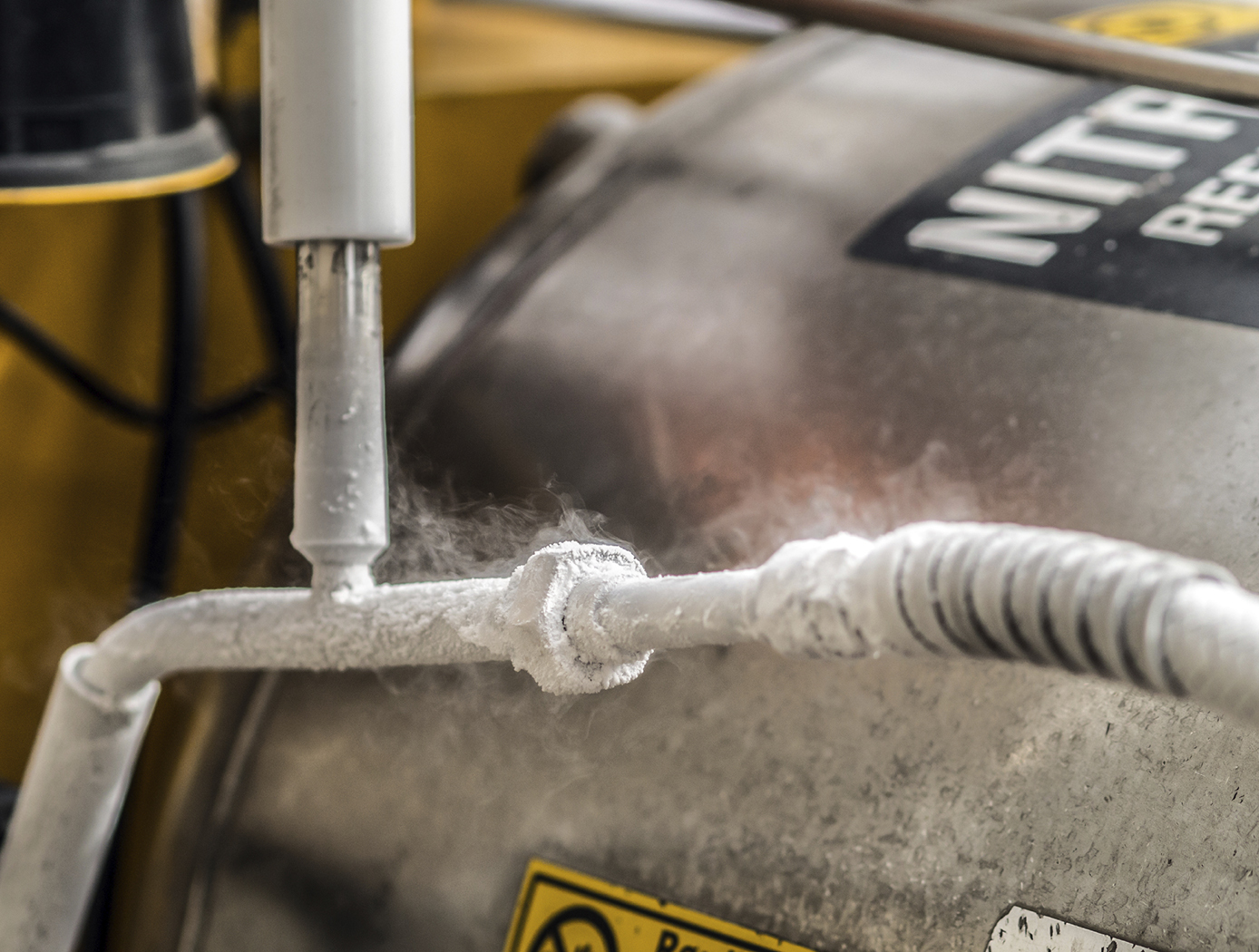Polyamide Aerogels
materials and coatings
Polyamide Aerogels (LEW-TOPS-31)
State-of-the-art, highly flexible aerogel materials
Overview
Sometimes referred to as "solid smoke," aerogels are the world's lightest solid materials, composed of approximately 85% air by volume. Polyamide aerogels open up a whole new world of applications due to their unique properties: translucent like silica aerogels; thermoplastic; ultra-low density; superior mechanical properties; low-temperature operating range; and highly flexible (as compared to NASA Glenn's polyimide aerogels). Polyamide aerogels are further novel because of their tunable glass transition temperatures, meaning that crystallinity -- and hence strength -- can be controlled via operating temperature. Addressing the key drawbacks of aerogel technology (hydroscopicity, fragility, cost), NASA Glenn's suite of organic aerogels are cost-competitive with both existing silica aerogels and, with scale-up, high-end foamed polymer insulation. Finally, Glenn's materials are truly multi-functional -- they can be structural members while providing superior thermal properties and extremely low dielectric (near that of air).
The Technology
Polyamides are polymers that are similar to polyimides (another polymer that has been developed for use in aerogels). However, because the amide link is a single chain while the imide link is a ring structure, polyamide aerogels can be made less stiff than polyimides, even though a similar fabrication process is used. The precursor materials can be made from any combination of diamine and diacid chloride. Furthermore, NASA Glenn researchers have found methods for using combinations of diamines and disecondary amines to produce polyamide aerogels with tunable glass transition temperatures, for greater control of features such as flexibility or water-resistance.
In the first step of the fabrication process, an oligomeric solution is produced that is stable and can be prepared and stored indefinitely as stock solutions prior to cross-linking. This unique feature allows for the preparation and transport of tailor-made polyamide solutions, which can later be turned into gels via the addition of a small amount of cross-linker. When the cross-linking agent is added, the solution can be cast in a variety of forms such as thin films and monoliths. To remove the solvent, one or more solvent exchanges can be performed, and then the gel is subjected to supercritical drying to form a polyamide aerogel. NASA Glenn's polyamide aerogels can be fully integrated with the fabrication techniques and products of polyimide aerogel fabrication, so hybrid materials which have the properties of both classes are easily prepared. As the first aerogels to be composed of cross-linked polyamides, these materials combine flexibility and transparency in a way that sets them apart from all other polymeric aerogels.


Benefits
- Versus silica aerogels: Weight, cost, flexibility, durability
- Versus polyimide aerogels: Flexibility, translucence
- Versus polymer foams: Thickness, performance
Applications
- Construction (e.g., insulation)
- Garments (e.g., protective clothing)
- Appliances (e.g., better insulation in refrigerators)
- Camping gear (e.g., tents and sleeping bags)
Technology Details
materials and coatings
LEW-TOPS-31
LEW-19053-1
LEW-19335-1
LEW-19053-2
LEW-19335-2
Similar Results

Optically Transparent Polyimide Aerogels
Innovators at NASA Glenn have devised a new method for harnessing the high transmission and clarity associated with optical glasses in a robust polyimide aerogel. This process uses sol-gel synthesis technology with aromatic dianhydrides and diamines as the precursors, and a trifunctional triacid chloride that arranges itself into a three-dimensional (3D) matrix with a low refractive index. The liquid portion of the gel is then removed by supercritical fluid extraction in order to produce the polyimide aerogel and maintain the desired 3D structure without pore collapse. The result is a cross-linked polyimide aerogel that allows for light wave transmittance while retaining low thermal conductivity. This unique material can be made into thin blocks, or highly flexible films as thin as 0.5 mm. While some embodiments have a yellow color, other embodiments may be nearly colorless. When compared to high-opacity polyimide aerogels, they have much greater surface area (up to 880 m2/g) and a very homogenous pore size (10 to 20 nm) with only a minor penalty in density (0.15 g/cc vs 0.10 g/cc). These strong, optically transparent aerogels incorporate a number of unique properties with applicability to a host of potential new applications, making this innovation a game-changer in the global aerogel market. Glenn welcomes co-development opportunities.

Polymer Cross-Linked Aerogels (X-Aerogels)
Researchers at NASA's Glenn Research Center have developed an approach to significantly improve the mechanical properties and durability of aerogels without adversely affecting their desirable properties. This approach involves coating conformally and cross-linking the individual skeletal aerogel nanoparticles with engineering polymers such as isocyanates, epoxies, polyimides, and polystyrene. The mechanism of cross-linking has been carefully investigated and is made possible by two reactions: a reaction between the cross-linker and the surface of the aerogel framework and a reaction propagated by the cross-linker with itself. By tailoring the aerogel surface chemistry, Glenn's approach accommodates a variety of different polymer cross-linkers, including isocyanates, acrylates, epoxies, polyimides, and polystyreneenabling customization for specific mission requirements. For example, polystyrene cross-linked aerogels are extremely hydrophobic, while polyimide versions can be used at higher temperatures. Recent work has led to the development of strong aerogels with better elastic properties, maintaining their shape even after repeated compression cycling. By tailoring the internal structure of the silica gels in combination with a polymer conformal coating, the aerogels may be dried at the ambient condition without supercritical fluid extraction.

Durable Polyimide Aerogels
Aerogels are highly porous, low-density solids with extremely small pore sizes, fabricated by forming a gel from a solution in the wet-gel state that is then converted to the dry-solid state without compaction of the porous architecture. Aerogels make excellent electrical, thermal, and acoustic insulators. However, most inorganic silica aerogels are fragile and shed dust. The NASA Glenn team is the first to synthesize three-dimensional polymer aerogel networks of polyimides cross-linked with multifunctional amine monomers. Compared to silica aerogels, these aerogels retain small pore sizes and low thermal conductivities, but are distinguished by their flexibility. Polyimide aerogels are not brittle, fragile, or dusty like silica aerogels. Plus, polyimide aerogels possess the beneficial characteristics and strength of polyimide materials. The results are cross-linked polyimide aerogels with little shrinkage, low densities, high compression and tensile strengths, and good moisture resistance. They can be fabricated or machined into net shape parts, which are strong and stiff, or cast as thin flexible films with good tensile properties. Extremely customizable, polyimide aerogels can be formed into any configuration (e.g., wrapped around a pipe, sewn into protective clothing, or molded into a panel to act as a heat shield in a car). In short, Glenn's innovation improves the performance, adaptability, and affordability of aerogels in a broad number of applications.

Aerogel Reinforced Composites
GRC's aluminosilicate aerogel composites are fabricated using a sol-gel technique. A sol is formed by hydrolyzing an alumina dispersion in acid solution; the alumina may be combined with a silicon precursor to create a sol.
Fabrics, papers, and felts are used as reinforcing fibers to form an aerogel composite. The aerogel adheres to the reinforcement without use of sizing or organic binders. (In the case of sized fabrics, the sizing is first removed by heat cleaning.) Composites can be fabricated in a batch process, impregnating individual layers of paper, felt or fabric with the precursor sol, or in a roll-to-roll process. The sol is allowed to gel, and then aged for several days prior to supercritical drying using liquid CO2. Heat treatment of the super critically dried composites can be used to tailor the alumina or Aluminosilicate crystal structure and pore size.
In contrast to commercially available insulations, GRC's innovation provides extremely low thermal conductivity (60 mW/m-K at 900°C in argon) at high temperatures, thus enabling use at higher temperatures and improving applicability. In addition, GRC's unique process provides very good adhesion of the aerogel to its reinforcing fibers in alumina papers and zirconia felts, eliminating the spalling seen in other aerogel composites. Finally, GRC's innovation demonstrates low density and extreme resilience to high temperatures and harsh conditions. Seven layers of composite material of 1.25 mm/layer produced a temperature drop of 700°C when tested in the 8-foot high-temperature wind tunnel (8 HTT) at NASA's Langley Research Center. The technology also has withstood heat tests of up to 1200°C. In combination with other insulators, it has withstood fluxes of up to 65 W/cm2, producing a temperature drop of 625°C across 8 mm.

Highly Thermal Conductive Polymeric Composites
There has been much interest in developing polymeric nanocomposites with ultrahigh thermal conductivities, such as with exfoliated graphite or with carbon nanotubes. These materials exhibit thermal conductivity of 3,000 W/mK measured experimentally and up to 6,600 W/mK predicted from theoretical calculations. However, when added to polymers, the expected thermal conductivity enhancement is not realized due to poor interfacial thermal transfer.
This technology is a method of forming carbon-based fillers to be incorporated into highly thermal conductive nanocomposite materials. Formation methods include treatment of an expanded graphite with an alcohol/water mixture followed by further exfoliation of the graphite to form extremely thin carbon nanosheets that are on the order of between about 2 and about 10 nanometers in thickness. The carbon nanosheets can be functionalized and incorporated as fillers in polymer nanocomposites with extremely high thermal conductivities.



